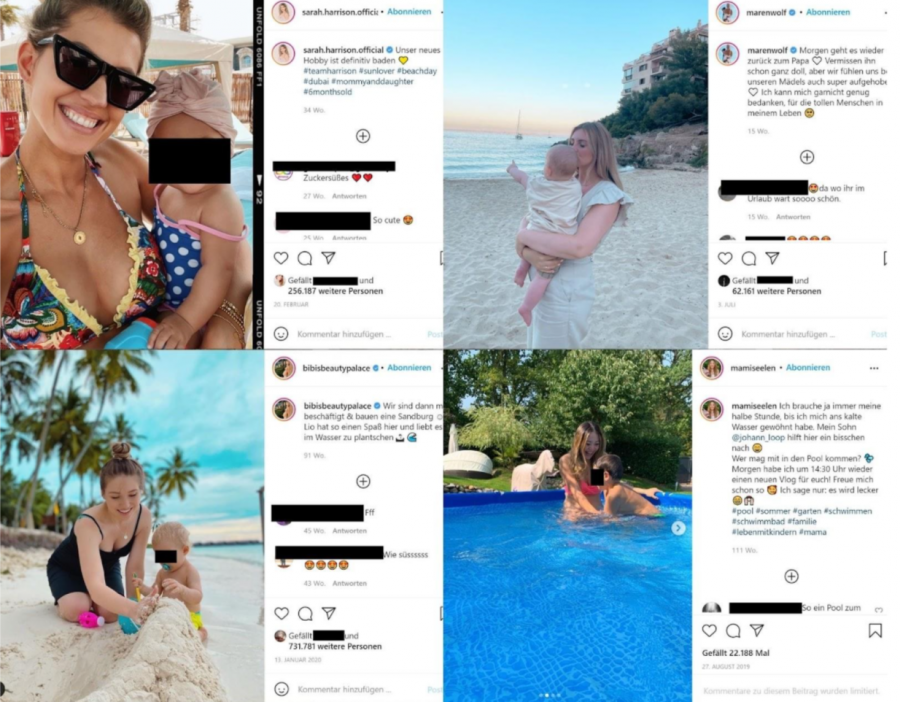
#MillionDollarBabies. Sharenting and its influence on kids
"Say cheeeeese!" "Come on kids, let's smile at the camera." #familygoals #happykids. These are words and hashtags that you come across very often when you watch videos of influencers presenting their children on social media. But how is life really behind the scenes of these families and above all, how happy are kids that are unwittingly presented to an audience of millions without being able to defend themselves or even being aware of the consequences?
It is clear that social media use seems to be on the rise since their debut. Increasing possibilities and features are emerging that make certain content, such as posts, videos, or tweets, more attractive and exciting, with the result that private insights are being shared in public more and more frequently. At the same time, social media platforms such as Instagram, YouTube, TikTok or Twitter have long since ceased to be platforms used only by young people. Currently, however, adults are using social media as well.
What is sharenting?
In recent years, the phenomenon of sharing has become increasingly popular among both influencers and followers. Sharenting, which is made up of sharing and parenting, refers to the sharing of images of one's own upbringing or children on the internet and is carried out by the parents themselves. Accordingly, sharenting offers another form of digital self-expression (Blum-Ross & Livingstone, 2017). Pictures or videos of their own children are posted on social networks.
In the case of so-called "family influencers", there are usually 6 so-called "domestic fillers", i.e. content that is particularly popular. These include the sharing of milestones in the development of children (developmental milestones), the sharing of family occasions or celebrations (family occasions), the recording of everyday life in the family (errands), private conversations (confessions), the reaction of children to current events (reactions) and insights into how family influencers deal with their fame and the relationship with their followers (logistics) (Abidin, 2017).
The reasons for sharing one's children with the public and one's followers are complex. Parents can find support on social media, have the opportunity to stay in touch with others affected, and even have the possibility for additional income. A study by Duggan et al. (2015) shows that 59% of parents who use social media report that they have come across useful information specifically about raising children in the past 30 days while viewing other content on social media. But the financial advantage that children's photos or videos bring should not be underestimated either. For parents whose online identities can be monetized, such as professional influencers, children can become part of the promotional activities carried out for brands (Abidin, 2017). Content featuring children is particularly popular on YouTube and Instagram. From 'pregnancy announcement' to 'gender reveal' and 'name reveal' to the birth report. All these videos are uploaded again and again by parents-to-be - especially influencers - over nine months and enjoy great popularity.
Since professional influencers earn their money with product placements or advertisements in precisely such videos, blogs, or Instagram posts, it seems logical to upload content that will be clicked on by as many people as possible and thus increase advertising revenue. The children of these family influencers thus unwittingly become 'child microcelebrities' themselves (Abidin, 2017). Sharenting can be found in many countries. This paper focuses on German influencers who present information about their child/children on Instagram. Since many influencers also maintain a YouTube channel in addition to Instagram, YouTube videos by German influencers are also taken into consideration. So much for the parents. But what about the children?
Public and academic debates about sharenting highlight the difficult dilemmas that arise from parents' right to self-expression and children's right to privacy (Jorge et al., 2021). Underage children, often even babies, who neither know what happens to their photos, cannot understand the consequences of such images and certainly do not have the possibility to defend themselves against them. Not without reason, according to Instagram, users must be at least 13 years old and YouTube users at least 16 years old to create or use an account. (Instagram, 2021; YouTube, 2021) Studies show that 27% of parents have shared a photo of their child on social media that appeared inappropriate (C.S. Mott Children’s Hospital, 2015).
But where do parents draw the line between children's privacy and publicity? Or where should it be? To understand this, it is worth taking a closer look at the definitions and developments of the private sphere and public sphere.
Private and Public - A strict line
The spheres of the public and the private have undergone significant developments in recent centuries. Even before increasing globalization, the private and public spheres were strictly defined and lived out separately from each other, whereas nowadays these two realms can no longer be precisely separated. In the following, the philosophers Jürgen Habermas and Hannah Arendt will be explained in more detail with regard to their theories on private and public spheres.
One of the most important political philosophers who helped shape the discourse on private and public spheres was Jürgen Habermas. According to Habermas (1989), the evolution of the public sphere in the 18th century goes hand in hand with industrialization and - analogously - the development of a capitalist market economy. He sees the public sphere as a metaphor for critical discussions in society, where people come together. These rational critical debates could take place because on these occasions people were free from traditional authorities such as the state and the church. The public sphere was therefore fundamental for people to form their own opinions independently of those authorities. It should be noted here that it was irrelevant whether everyone held the same opinion. In contrast to the public sphere, where rational critical debates took place, the private sphere was the realm of family and home life, theoretically free from the influence of government and other social institutions (Crossman, 2019; Habermas, 1989).
Similar to Habermas, Arendt (1958) also makes a precise separation in the definition of private and public. The public sphere forms a public space for debate and interaction with others, while the private sphere builds a private space for security and protection, where people can recover from the stresses and strains of the public sphere. Arendt (1958) emphasizes the plurality that is necessary in public discourse in order to see equality in human beings. In this context, the public sphere offers space for political action, which is also everyone's responsibility. As soon as we talk about private or intimate things, we bring them into the public sphere, which is why it is important to keep certain things private. Moreover, according to Arendt, there are things that can only survive in the private sphere - like love. ''Everything that appears in public can be seen and heard by everybody'' shows quite well how carefully one should consider what details one brings into the public sphere. In order to maintain lively politics, both spheres should be separated (Arendt, 1958). Arendt says it’s the common world that ’’gathers us together and yet prevents our falling over each other’’ (Arendt, 1958, p. 52).
Sharenting - between joy and abuse
So for a long time, privacy was kept out of the public sphere. Through mass media and social networks, which thrive on private individuals sharing their lives with the public, this has long since ceased to be the case. In the following, the content shared by children, how it is staged, and how popular it is will be analyzed in relation to sharenting on the basis of German influencers. German laws are also taken into consideration. The topic of pregnancy is particularly popular with (family-) influencers. From the announcement to the gender reveal to the birth report, the same topics are usually found on Instagram among German influencers. The picture below shows pregnancy announcement posts from the six German influencers used as case studies in this article who all have between 500,000 and 8,000,000 followers (see Instagram pages of: mamiseelen, dagibee, sarah.harrison.official, marenwolf, bellakraus, bibisbeautypalace).
 © Barop, 2020a; Harrison, 2020; Heinicke, 2019b; Kazakov, 2021a; Kraus, 2020a; Wolf, 2019
© Barop, 2020a; Harrison, 2020; Heinicke, 2019b; Kazakov, 2021a; Kraus, 2020a; Wolf, 2019Pregnany announcements

Pregnany announcements
As can be seen from the images, the private insights around the pregnancy of such influencers usually follow the same pattern. Even here, it is debatable whether these private insights should be shared in public. However, the more significant discussion starts when these children are presented to this large audience from birth onwards. On YouTube, more and more German videos can be found that fight for data protection and the rights of children (Alicia Joe, 2021; maiLab, 2021; MrWissen2go, 2021; reporter, 2021). Each of the influencers shown above also runs a YouTube channel on the side, on which entire videos about and with the children are often published. The child's face is often shown and private details about the child are revealed. The laws and guidelines that this violates in Germany are described below.
Legal or illegal?
Even though parents in Germany can decide what happens to the pictures of their children up to the age of 14 (Kanzlei WBS, 2021a) personal rights can also be violated under the age of 14, for example, if children are seen in embarrassing situations (Kanzlei WBS, 2021b). This also includes crying or sick children (MrWissen2go, 2021). In addition, there are photos that by definition invade children's privacy (Kanzlei WBS, 2021a). These include, for example, naked pictures, photos in the bathtub or on the beach. Figure 4 shows some pictures of the above-mentioned influencers that violate the child's privacy (Barop, 2019; Harrison, 2021; Heinicke, 2020b; Wolf, 2021). Any kind of unidentification is added by the author and not inserted by the influencers themselves.

Pictures that violate children's privacy.
Both pictures in which children have little on them and supposedly harmless pictures of children repeatedly end up in the hands of pedophiles and associated forums (American Academy of Pediatrics, 2016; Battersby, 2015; Judah, 2016). To prevent this, YouTube itself sets up guidelines for the protection of children (YouTube, 2021) which show that videos in which personal details about minors are revealed are actually not allowed. Recordings from children's bedrooms also fall into this category, although many YouTubers do not take this into account (Mamiseelen, 2021; Team Harrison, 2021). It is frightening to see that if personal rights, privacy, and the guidelines of the social media sites themselves are not respected, with a little research you can find out from many children what their hobbies are and even where they go to school or kindergarten by using their first and last names, as well as various posts.
Changes in the private and public - blurred lines
It shows that the safe space - the home and the family - which has always been kept in the private sphere, suddenly becomes part of the public sphere.
The CPM theory by (Petronio, 2002) explains that as soon as information is shared, others become co-owners of the information. Children's pictures can be unknowingly copied and end up on questionable sites. Therefore, personal and interpersonal boundaries need to be negotiated, which is not yet possible with children. Studies show that privacy management - how one deals with one's own privacy - correlates positively with age and that young people are stricter in managing boundaries with parents than with peers (Wolf, 2020). In relation to influencers who present their children to the public, this could actually still have consequences for parents when the children are older. Respecting privacy alone is good, but it is not enough (Wolf, 2020). This is because social media brings with it 5 affordances: Persistence, Replicability, Scalability, Searchability (Boyd, 2010), and Shareability (Papacharissi & Gibson, 2011).
In conclusion, this means that influencers may not even be aware of how often a picture of the child has actually been seen, by whom it is viewed or even rated, and how often and on which forums it is shared. An image can spread unknowingly millions of times and will remain visible forever. In addition, everyone should also be aware of their ethical responsibilities on social media. According to Miller, we must strive to create ethical encounters in media communication (Miller, 2012). Another critical point is the monetization of posts with children, through which parents earn their living. Fuchs, who argues for restricted social media, speaks of three antagonisms that characterize today's social media world. One of them is the economic antagonism between users' data and the profit interests of social media concerns (Fuchs, 2014). Private (family) and public (corporations) can therefore no longer be strictly separated.

After birth pictures
Final thoughts
It is clear that in today's world, a clear distinction between private and public spheres can no longer be made. This is not only due to the private insights that social media can offer, but also to the globalization of society, increasing mobility, neoliberal policies, and the employment crisis (Fuchs, 2014). Habermas also recognizes that the public sphere in the 21st century is becoming dependent on commercial advertising and is being segmented due to the many forums and new technologies. In terms of influencers, this means that they earn a lot of money by sharing children's photos and videos.
In order to fully protect the privacy of children, law professor and pediatrician Keith & Steinberg (2017) have produced an advice guide for parents. This advocates the following: Familiarise yourself with the privacy policies of websites, set up alerts to inform you when your child's name comes up in search engines (Google Alerts/Talkwalker Alerts), and remain anonymous. They also recommend being cautious before sharing the child's actual location or full name and not posting pictures of the child unclothed. Furthermore, they recommend offering older children a 'veto' over online postings and not forgetting the impact that sharing can have on the child's present and future self-esteem and well-being (Keith & Steinberg, 2017).
And there seems to be a rethink in Germany, at least among some influencers. Some influencers decided to stop showing their children's faces or pixelate them. Maren Wolf said this year that she and her husband decided not to show their child's face anymore (H., 2021). Bibisbeautypalace, who showed her son in the meantime, no longer shows her children from the front. It is similar to bellakraus. All pictures and videos showing the children's faces have since been deleted from Instagram and YouTube. Accordingly, it seems that privacy and the fight for it are slowly having an effect, even if the majority of influencers are still revealing information and data about their children.
References
Abidin, C. (2017). #familygoals: Family Influencers, Calibrated Amateurism, and Justifying Young Digital Labor. Social Media + Society, 3(2), 205630511770719.
Alicia Joe. (2021, October 27). Familienblogger: Wenn Unterhaltung Jugendschutz gefährdet. YouTube.
Arendt, H. (1958). The human condition (2nd ed.). The University of Chicago Press.
Blum-Ross, A., & Livingstone, S. (2017). “Sharenting,” parent blogging, and the boundaries of the digital self. Popular Communication, 15(2), 110–125.
Boyd, D. (2010). Social Network Sites as Networked Publics: Affordances, Dynamics, and Implications. In Z. Papacharissi (Ed.), A Networked Self (pp. 47–66). Routledge.
Crossman, A. (2019, August 31). Understanding Private and Public Spheres. ThoughtCo.
Fuchs, C. (2014). Social Media and the Public Sphere. TripleC: Communication, Capitalism & Critique. Open Access Journal for a Global Sustainable Information Society, 12(1), 57–101.
Habermas, J. (1989). The Structural Transformation of the Public Sphere: An Inquiry into a Category of Bourgeois Society ((T. Burger & L. Kert, Trans.)). MIT Press.
Jorge, A., Marôpo, L., Coelho, A. M., & Novello, L. (2021). Mummy influencers and professional sharenting. European Journal of Cultural Studies, 136754942110045.
Keith, B. E., & Steinberg, S. (2017). Parental Sharing on the Internet: Child Privacy in the Age of Social Media and the Pediatrician's Role. JAMA Pediatrics, 171(5), 413–414.
maiLab. (2021, October 27). Sollte ich mein Kind im Internet zeigen? YouTube.
Miller, V. (2012). A Crisis of Presence: On-line Culture and Being in the World. Space and Polity, 16(3), 265–285.
Papacharissi, Z., & Gibson, P. L. (2011). Fifteen Minutes of Privacy: Privacy, Sociality, and Publicity on Social Network Sites. In S. Trepte & L. Reinecke (Eds.), Privacy Online (pp. 75–89). Springer Berlin Heidelberg.
Petronio, S. (2002). Boundaries of Privacy: Dialectics of Disclosure. SUNY Series in Communication Studies. State University of New York Press.
reporter. (2021, October 27). Kinder-Influencer: Ist das schon Arbeit? | reporter. YouTube.
Team Harrison. (2021, October 28). FINAL ROOMTOUR DUBAI 🤩 Team Harrison. YouTube.
Wolf, R. de (2020). Contextualizing how teens manage personal and interpersonal privacy on social media. New Media & Society, 22(6), 1058–1075.
YouTube. (2021, October 27). Richtlinien zum Schutz von Kindern - YouTube-Hilfe.